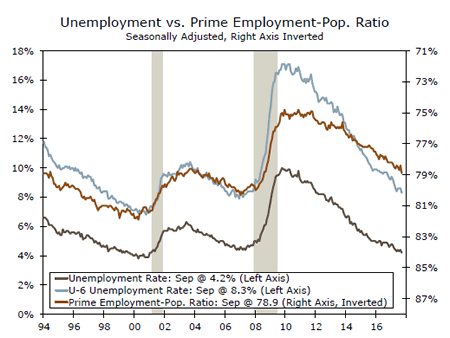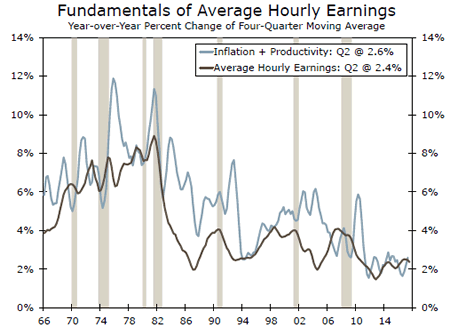U.S. Review
U.S. Manufacturing Strengthening with Global Growth
- Non-defense capital goods orders ex-aircraft, our preferred gauge of future business investment, rose a strong 1.3 percent in September, the third consecutive monthly gain of that size.
- New home sales rebounded 18.9 percent in September to a 667,000-unit annual rate, the highest level of new home sales since October 2007.
- Real GDP grew at a 3.0 percent annualized rate in Q3, topping expectations for a 2.6 percent gain. Given the possibility for hurricane-related noise in the quarterly data, the print appeared relatively devoid of head-scratching outliers.
U.S. Manufacturing Strengthening with Global Growth
On Wednesday, preliminary data on durable goods orders in the United States showed a continued firming in factory sector data to end the third quarter. Durable goods orders rose 2.2 percent in September, boosted by another double-digit jump in the volatile civilian aircraft component. Communications equipment posted a suspiciously large gain, so there may have been some additional noise generated by the recent release of the new iPhone.
Non-defense capital goods orders ex-aircraft, our preferred gauge of future business investment, rose 1.3 percent in September, the third consecutive monthly gain of that size. This string of strong prints puts the three-month average annualized rate at 11.6 percent, the fastest pace of growth since the eve of the steep decline in the price of oil in September 2014. With three-quarters of the year in the books, the recovery in the factory sector that has taken place in 2017 has built momentum in the second half of the year (top chart). The strong dollar/weak global growth/falling commodity price story that characterized the past two years has reversed in 2017, turning these headwinds into tailwinds for the sector. Manufacturers have responded by increasing payrolls by 104,000 jobs this year.
Housing data this week were encouraging, as new home sales rebounded 18.9 percent in September to a 667,000-unit annual rate, the highest level of new home sales since October 2007. The new home sales series is notoriously volatile and has bounced around even more than usual due to the relatively low absolute level of sales. Sales surged 25.8 percent in the South and accounted for nearly 80 percent of September’s increase. The number of homes for sale was unchanged, but the stronger sales pace cut the months’ supply by a full month to 5.0 months. Homes priced for $300,000 or more accounted for most of the sales gain, lifting both average and median home price measures (middle chart).
The advance release of third quarter GDP this morning capped the week of U.S. economic data. Given the possibility for hurricane-related noise in the quarterly data, the print appeared relatively devoid of head-scratching outliers. Real GDP grew at a 3.0 percent annualized rate in Q3, topping expectations for a 2.6 percent gain. Real personal consumption grew at a trend-like 2.4 percent in the quarter, while business equipment spending posted another solid quarter of growth (8.6 percent following an 8.8 percent gain in Q2). Residential construction saw a second quarterly decline, and government consumption and investment was slightly down, weighed down by the state & local component.
The firming global growth environment and softer dollar have helped boost economic growth in the United States. International trade once again added positively to growth, boosting the headline real GDP number by 0.4 percentage points amid a 2.3 percent gain in exports and a small decline in imports. Net exports have been additive to growth in all three quarters of the year so far, the first string of three consecutive boosts to growth since a stretch that ran from mid-2012 through Q1-2013 (bottom chart).
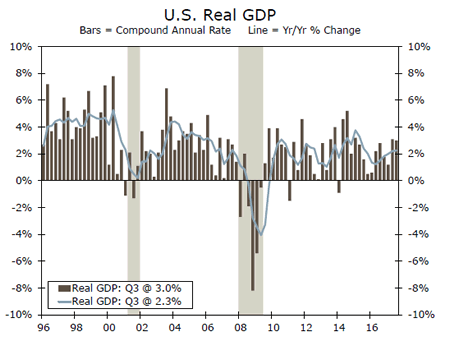
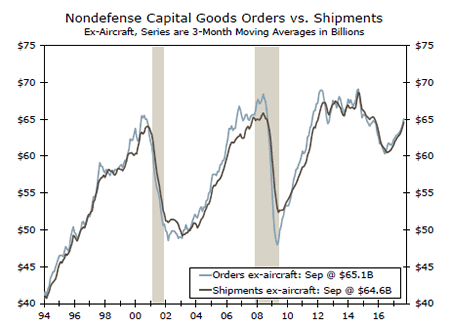
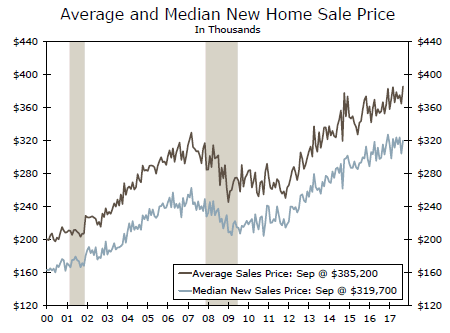
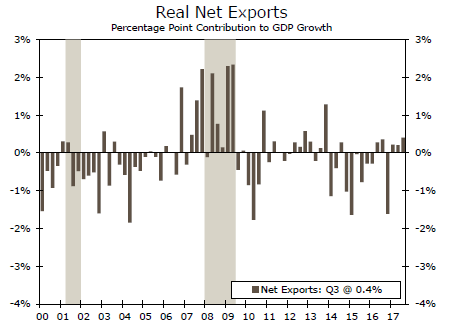
U.S. Outlook
Personal Income • Monday
After increasing 0.2 percent in August, personal income growth is expected to strengthen 0.5 percent in September. Wage growth has improved in recent months, including a solid rise in hourly earnings in September. We also expect to see some support from income earned on financial assets, as the stock market hit a fresh high in September.
After adjusting for inflation, the pickup in income will look less impressive. The PCE deflator, the Fed’s preferred measure of inflation, likely rose 0.4 percent last month. Much of the rise can be traced to higher energy prices, while core inflation is expected to rise only 0.1 percent. Spending will have also gotten a lift from higher energy prices, as well as strong auto sales. We forecast personal spending to have risen 0.7 percent in September.
Previous: 0.2% (Month-over-Month) Wells Fargo: 0.5% Consensus: 0.4%
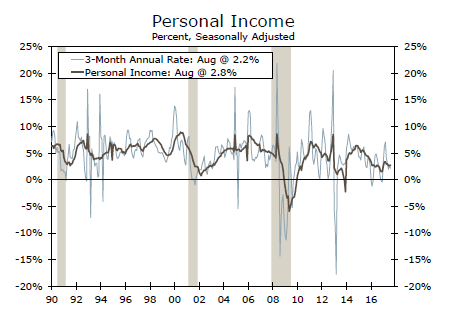
ISM Manufacturing • Wednesday
Last month’s ISM manufacturing index climbed to a 13-year high of 60.8. That was in part driven by a surge in supplier delivery times following Hurricanes Harvey and Irma. Even stripping out the delivery component, however, the ISM manufacturing index has signaled strengthening activity. In addition to a rise in production and employment, the new orders index improved to 64.6 last month while backlogs have been growing this year at the strongest pace since the mid-2000s.
We expect the ISM manufacturing index to signal a slightly slower pace of growth in October. The lower reading will be driven by payback from the storm-related lengthening of delivery times last month. At 59.6, however, the ISM would be consistent with activity in the manufacturing sector still expanding at a robust clip.
Previous: 60.8 Wells Fargo: 59.6 Consensus: 59.5
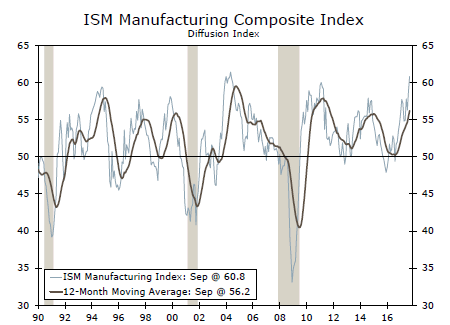
Employment • Friday
Last month’s 33,000 decline in employment snapped a nearly seven-year string of uninterrupted job growth. The decline in employment was attributable to the recent hurricanes having disrupted hiring plans and preventing some jobholders from working during the survey period. Those distortions should be largely unwound in October, however. Initial jobless claims have fallen back below 240,000, the level that prevailed in the months leading into hurricane season.
We expect to see hiring rebound to 280,000 in October as employers catch up on hiring and workers return to their jobs. The unemployment rate, however, is anticipated to tick up to 4.3 percent following last month’s suspiciously large 906,000-jump in household employment.
Previous: -33,000 Wells Fargo: 280,000 Consensus: 310,000
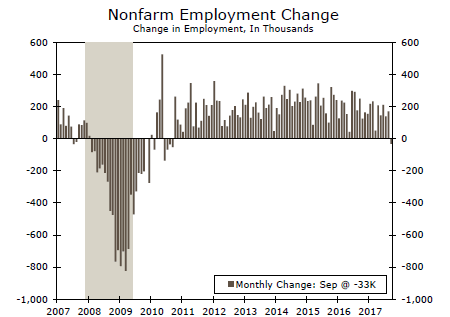
Global Review
Less Policy Accommodation Slowly Coming Into View
- The ECB decided this week to "taper" its QE program further due, at least in part, to strong growth momentum. However, benign inflation means that any rate hikes are still some ways off.
- Stronger-than-expected U.K. GDP data in Q3 means that a rate hike by the Bank of England is likely at next week’s Monetary Policy Committee meeting.
- The Bank of Canada remained on hold this week, but it continued to indicate that further tightening, albeit at a slow pace, is likely in the quarters ahead.
Less Policy Accommodation Slowly Coming Into View
The European Central Bank (ECB) held a regularly scheduled policy meeting on Thursday and, as widely expected, the Governing Council decided to "taper" its quantitative easing (QE) program further (see chart on front page). Specifically, the Governing Council announced that it would dial back its monthly rate of bond purchases from €60 billion to €30 billion starting in January, and that it would maintain that pace through September 2018, "or beyond, if necessary."
Recent data out of the euro area indicate that the economy does not need as much policy support as it did earlier. Real GDP in the Eurozone was up 2.3 percent in Q2-2017, the strongest rate of economic growth in more than six years, and the elevated level of the purchasing managers’ indices suggest that growth momentum in the euro area remained solid in the third quarter (top chart).
However, inflation in the euro area remains benign—the core rate of CPI inflation was only 1.1 percent in September—indicating that a complete removal of policy accommodation probably would not be appropriate at this time. The Governing Council kept its three policy rates unchanged, and it continued to stress that they would "remain at their present levels for an extended period of time, and well past the horizon of our net asset purchases." In short, rate hikes in the Eurozone are probably some ways off still.
In contrast, monetary tightening in the United Kingdom likely will happen sooner rather than later. Data released this week showed that real GDP in the United Kingdom grew 0.4 percent (1.6 percent at an annualized rate) on a sequential basis in the third quarter (middle chart). The outturn was slightly stronger than many analysts had expected, and it stoked expectations that the Monetary Policy Committee (MPC) of the Bank of England (BoE) will hike rates by 25 bps at its policy meeting next week.
We had thought the MPC would wait until February before hiking rates, but the stronger-than-expected GDP result in conjunction with the still elevated rate of CPI inflation (3.0 percent in September) mean that a rate hike next week now seems likely. If, as we now expect, the MPC indeed raises its Bank Rate by 25 bps next week, it would be the first time that the MPC has hiked rates in more than 10 years. But any tightening that the MPC undertakes in the coming year likely will occur at a slow pace.
As widely expected, the Bank of Canada (BoC) refrained from raising its main policy rate this week. The BoC had hiked rates by 25 bps at its last two policy meetings (bottom chart), so a third consecutive rate hike seemed a bit aggressive to most market participants. In the press release announcing the decision, the BoC acknowledged that "less monetary policy stimulus will likely be required over time," but that it "will be cautious in making future adjustments to the policy rate." In other words, further rate hikes will be forthcoming but the pace of tightening likely will be slow. In that regard, we look for the BoC to hike rates by a total of 50 bps next year.
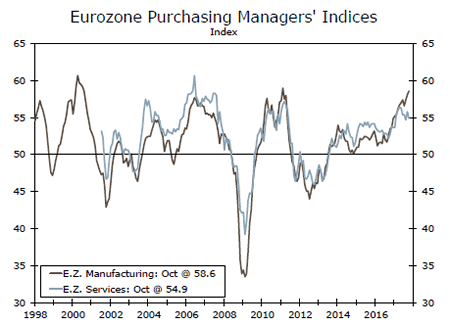
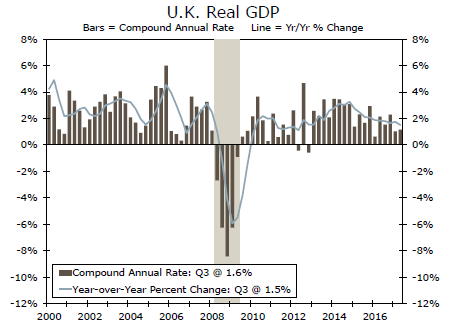
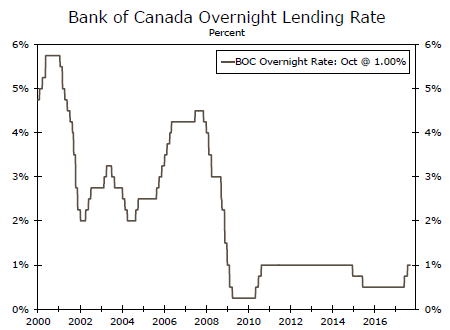
Global Outlook
Eurozone GDP • Tuesday
Next Tuesday will provide us with the advanced GDP report for Q3 as well as the October CPI report for the Eurozone. Economic growth has become increasingly broad based in recent quarters amid steady employment gains and improving business sentiment. The expansion has led to firmer conditions in the labor market. However, despite the solid rate of real GDP growth and the tightening in labor market conditions, inflation remains benign.
Real GDP accelerated in the Eurozone in Q2, as the year-ago pace of economic growth crossed the 2 percent threshold for the first time since Q1-2011. The outturn marks the 17th consecutive quarter in which real GDP has risen on a sequential basis. Real GDP in the overall euro area is up 7.0 percent since the mild 2011-13 recession ended. We expect GDP in the Eurozone to grow 2.4 percent in Q3, year over year, and to expand 2.2 percent and 2.1 percent in 2017 and 2018, respectively.
Previous: 2.3% (Year-over-Year) Wells Fargo: 2.4% Consensus: 2.3%
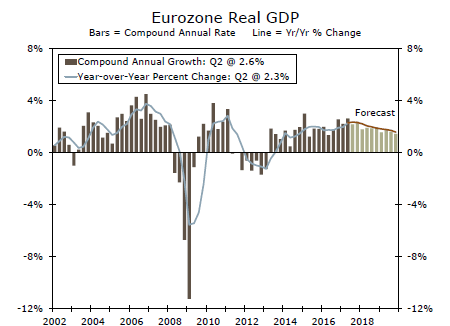
Mexico GDP • Tuesday
Mexican Q3 GDP is slated for release next Tuesday. The monthly data flow for July and August has not been as robust as one might have hoped. Industrial production started the quarter on a negative note, with construction activity declining 1.0 percent versus June, before increasing just 0.3 percent in August. Mining activity declined 2.3 percent while utilities output fell 0.5 percent on the month.
A bright spot in the Mexican economy is the manufacturing sector, which is largely driven by its automobile production. Manufacturing activity increased 0.5 percent in August from July and is up 3.3 percent on a year-earlier basis. Perhaps one of the most important reasons why the current NAFTA renegotiation process taking place between the United States, Canada and Mexico is so noteworthy is that the Mexican automobile sector is one of the most vital industries of Mexican production activity. We look for GDP to grow 1.9 percent in Q3.
Previous: 1.8% (Year-over-Year) Wells Fargo: 1.9%
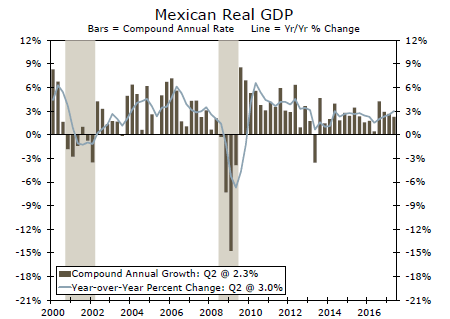
Bank of England (BoE) Meeting • Thursday
Financial markets appear convinced that the BoE will hike rates at the conclusion of the Monetary Policy Committee’s (MPC) meeting on November 2. The implied probability of an interest rate hike as of this morning was 88.7 percent. Previously we had thought the MPC would hold off and hike rates at the February meeting, however, the stronger than expected GDP data helped convince us to agree with the market expectation. The forthcoming rate hike from the BoE will likely be an increase in the Bank Rate by 25 bps, the increment in which it has tightened policy in the past.
Regardless of when the first move occurs, the pace of tightening through 2018 will likely remain gradual as inflation begins to recede and economic growth remains modest. Moreover, shadows cast by the ongoing Brexit negotiations continue to create uncertainly surrounding the U.K.’s relationship with the European Union moving forward. The MPC will likely proceed with caution.
Previous: 0.25% Wells Fargo: 0.50% Consensus: 0.50%
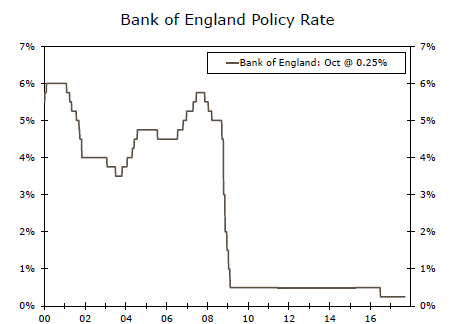
Point of View
Interest Rate Watch
Two and Tens, Alternative Forces
Since the start of this year, the behavior of the two and ten-year Treasury benchmark interest rates have behaved differently as each reflects the influence of alternative economic forces (top graph). As a result, the spread between the ten and two-year has declined throughout 2017.
Two Year: Upward Drift.
Since the start of 2017, the two-year yield has drifted upward. This is consistent with two factors: policy intentions and inflation. Since the fourth quarter of 2016, the policy intentions of the FOMC have signaled a pattern of rising fed funds rate increases consistent with an outlook for rising inflation, continued economic growth and lower unemployment. The economy has cooperated.
For the FOMC, the dot-plot has signaled their intentions. For the economy, the steady drift upward in the Cleveland Fed median CPI measure (middle graph) has reinforced the FOMC’s and financial market expectations. Therefore, the two year rate has reacted in line with the rise of inflation and therefore, the expected follow-on rise in the Fed Funds rate.
Ten-Year: Three Factors to Follow
Since the start of this year, the ten-year Treasury rate has drifted lower despite the rise in the two-year rate. The buy side of the Treasury market has been a key support for lower ten-year yields. First, the increase in foreign purchases of U.S. Treasury securities (bottom graph) has been a welcome turnaround from the declines of 2016. The global search for yield continues to benefit the U.S. sovereign debt market. Second, the pace of overall U.S. economic growth and inflation has remained modest and therefore the case for higher nominal GDP growth which was popular at the start of the year has moderated and thereby supported the case for a moderation of the ten year yield.
We began the year with a below consensus forecast for the ten-year rate and that has served us well. We are on the path to be more accurate than the consensus on the ten-year forecast for the fourth year in a row. Fundamentals matter in forecasting.
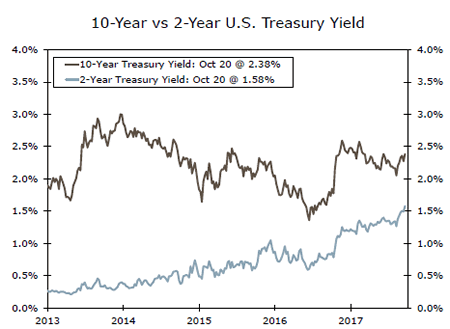
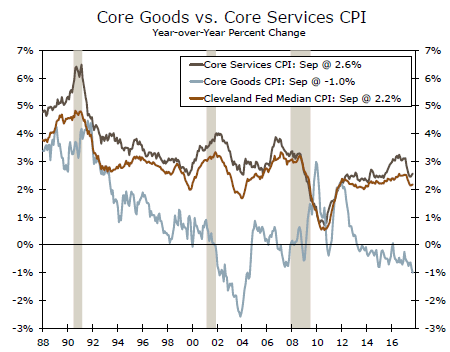
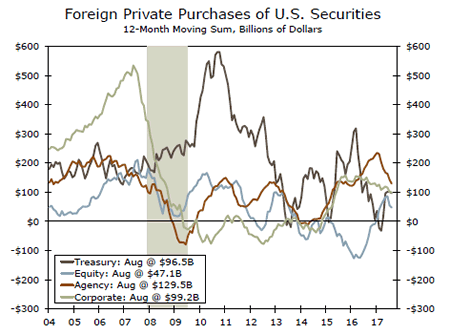
Credit Market Insights
Vehicle Ownership Down, Debt Up
Vehicle ownership rates began falling after the recession and have continued to decline since. Only 85.2 percent of families owned a vehicle in 2016, compared to 86.3 percent in 2013, according to the survey of consumer finance.
Urban areas tend to have lower vehicle ownership rates: 84.8 percent of metro area residents owned vehicles in 2016 versus 87.9 percent of rural residents. Meanwhile, urban areas are also seeing the bulk of population growth. In 2016, U.S. metro areas grew by more than 2 million people, while rural areas only added 40 thousand. Therefore, more families are living in dense cities with alternatives to vehicle transport.
Increasingly cities are prioritizing public transportation as part of an effort to attract new workers. Amazon included mass transit access as a requirement for the future location of its HQ2, highlighting the importance of car-free mobility to its young, educated workforce. This suggests that lower vehicle ownership is not transitory, but an effect of fundamental shifts in lifestyle.
As fewer families own vehicles, those who do owe more on their vehicles. Median vehicle debt rose by $500 to $12.8K from 2013 to 2016. Families in the lowest income quintile saw their vehicle debt rise the fastest, by 44 percent to $7.9K over the same period. Higher debt, especially for borrowers with lower credit, is a concern for delinquency rates.
Topic of the Week
Where Are We Headed with Wage Growth?
After years of strong employment growth, the path of wage and income growth is critical for policymakers at the Fed as they weigh additional monetary policy tightening. Indicators suggest gradual improvement: average hourly earnings, the Atlanta Fed Wage Growth Tracker and the Employment Cost Index (ECI) are all currently above their expansion averages on a year-overyear basis, and the trends are broadly upward.
Looking forward, will wages continue to strengthen? We believe the answer is yes. Indicators of slack in the labor market have finally reached full employment levels across a broad range of metrics. Both the traditional U-3 unemployment and the broader "underemployment" or U-6 rate are at previous cycle lows, survey-data suggest businesses are increasingly struggling to find qualified workers and the employment-population ratio for prime-age workers has finally returned to a more normal level. Although the road has been long and arduous, the return to full employment should spur greater competition for increasingly scarce labor resources, pushing up compensation.
That said, compensation is unlikely to return to the previous cycle-peak growth rates anytime soon. The fundamental drivers of wage growth are not conducive to the 4-6 percent growth range that occurred at the peak of previous expansions. Workers’ earnings should reflect their output, or in other words productivity. While productivity serves as the "real" driver of wage growth, workers also need to be compensated for inflation. During the current cycle, inflation and labor productivity growth have been persistently slow, making it not altogether surprising that earnings growth has been sluggish relative to previous cycles.
Next week, we get more information on recent wage and income growth with the release of personal income, ECI and average hourly earnings data. We expect personal income to be up 2.8 percent in Q3 and ECI to rise 2.5 percent over the same period, almost flat with Q2. For more information on the differences between wage indicators, see our recent report "525,600 Metrics: How Do You Measure a Year in Income Growth?"
